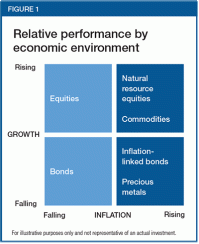To view a PDF of the full report click here.
Historically, consensus inflation forecasts have not been very accurate, in part because inflation is highly susceptible to market and macroeconomic shocks. Portfolio Manager Scott Elliott and Investment Director Ken Baumgartner contend that investors are better served by maintaining permanent strategic allocations to inflation-hedging real assets than risking tactical misfires.

Why do investors need a strategic allocation to real assets?
Elliott: The majority of institutional investors’ capital and risk budgets are in growth assets — equities and other assets that have generally performed best when economic growth has been rising and inflation has been falling. This environment is captured in the top-left quadrant of our Think Function, Not Form asset allocation framework (Figure 1). This is understandable. Capitalism strives to increase growth and limit inflation, and so we would expect growth assets to have the most attractive long-term returns. But equity bear markets exist, driven either by recessions, when high-quality government bonds (bottom-left quadrant) have been the best defense, or by inflationary regimes, when assets on the right side of the matrix have often performed the best. We view real assets as a hedge for inflationary regimes, just as government bonds have been a hedge for economic slowdowns.
A second critical point in favor of a strategic allocation is that the future is difficult to predict. There are many potential sources of inflation, including monetary expansion, commodity supply shocks, and positive changes in demand. Inflation can emerge quickly from any of them, and investors attempting to time diversification have often been unsuccessful.
What assets are best suited to a structural inflation hedge?
Baumgartner: Among the assets on the right side of Figure 1, there is no silver bullet. Natural resource equities have generally had the most attractive long-term expected returns with meaningful inflation sensitivity (beta to inflation). Commodities typically have the higher inflation beta — not surprising since commodity prices are direct and volatile components of inflation— but their returns may trail those of natural resource equities over time. Inflation-linked bonds offer modest inflation sensitivity while potentially providing a degree of stability to overall returns due to their lower volatility. In addition, they are one of the few assets that have done well in the bottom-right quadrant of Figure 1.

The performance of commodities and natural resource equities has been challenging recently. How should investors balance this reality against the need for inflation hedging?
Elliott: From a strategic asset allocation perspective, assets with a high sensitivity to inflation have performed at least directionally as one might expect in an environment where US headline CPI has moved from nearly 4% to zero over the past four years. While traditional equities and nominal bonds excelled over this period, real assets were a drag on overall portfolio performance. However, we think investors must recall the role of real assets in an asset allocation framework and fight the urge to shed diversifying exposures, something they often do at the worst times.
In addition, due to recent challenging fundamentals and general complacency about inflation, valuations for many inflation-sensitive assets are at extremely depressed levels. As with any hedge, it is generally best to buy when the assets are cheap. Returning to the issue of timing, it is unlikely that we will see both cheap valuations and inflation pressures simultaneously, since financial assets should start discounting a stronger inflation environment well in advance of the actual economic evidence. This reinforces the importance of a strategic allocation to the area.
What about fundamentals?
Baumgartner: In addition to assessing inflation sensitivity, expected long-term returns, and current valuations, we evaluate forward-looking supply/demand fundamentals and the likelihood of inflation across our real-asset opportunity set. Fundamentals have been a headwind for some time now, but we are seeing signs of a base being built that will allow fundamentals to transition to a tailwind in the future. For example, the energy sector has provided real-time evidence of the self-correcting nature of natural resources, with declining oil prices driving capital expenditure cuts across the industry. In our view, current oil prices are too low to meet future global demand expectations. While no one is predicting outsized inflation in the near term, a move up from current near-zero levels to a more normalized rate should be enough to provide a tailwind for these assets that are currently unloved by the majority of investors.
To learn more about this topic, visit:
www.wellington.com/case_for_real_assets
Contact information:
Ryan Randolph
rprandolph@wellington.com
1-617-951-5894
This material and/or its contents are current at the time of writing and may not be reproduced or distributed in whole or in part, for any purpose, without the express written consent of Wellington Management. This material is not intended to constitute investment advice or an offer to sell, or the solicitation of an offer to purchase shares or other securities. Investors should always obtain and read an up-to-date investment services description or prospectus before deciding whether to appoint an investment manager or to invest in a fund. Any views expressed herein are those of the author(s), are based on available information, and are subject to change without notice. Individual portfolio management teams may hold different views and may make different investment decisions for different clients. FOR INSTITUTIONAL INVESTORS ONLY





